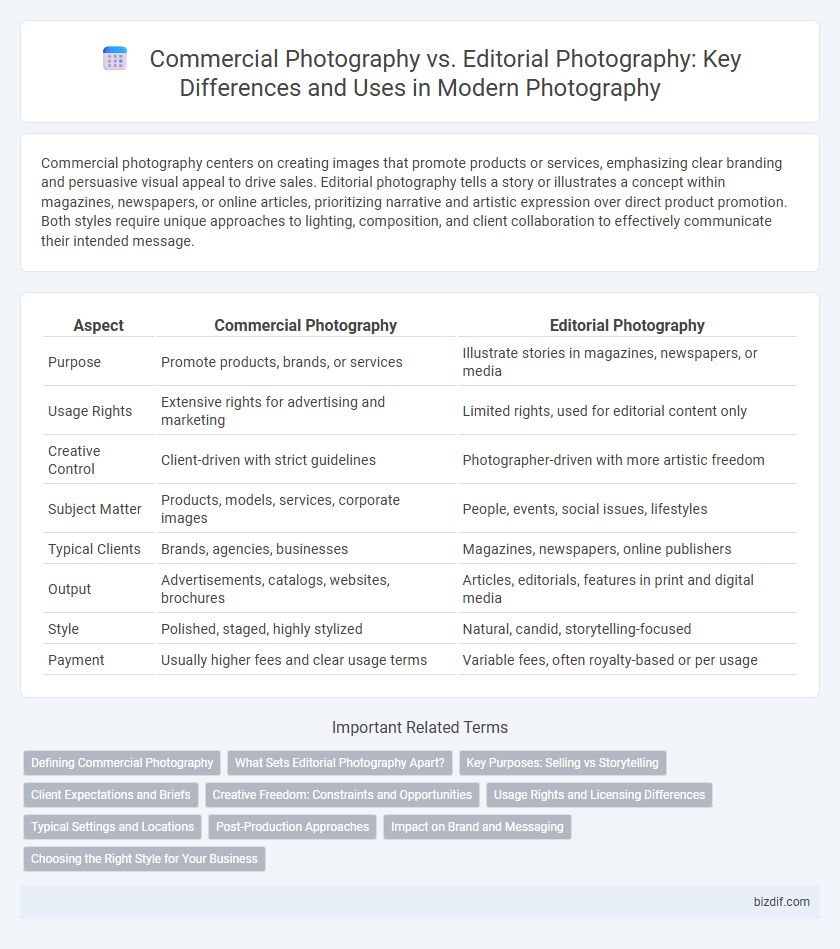Commercial photography centers on creating images that promote products or services, emphasizing clear branding and persuasive visual appeal to drive sales. Editorial photography tells a story or illustrates a concept within magazines, newspapers, or online articles, prioritizing narrative and artistic expression over direct product promotion. Both styles require unique approaches to lighting, composition, and client collaboration to effectively communicate their intended message.
Table of Comparison
| Aspect | Commercial Photography | Editorial Photography |
|---|---|---|
| Purpose | Promote products, brands, or services | Illustrate stories in magazines, newspapers, or media |
| Usage Rights | Extensive rights for advertising and marketing | Limited rights, used for editorial content only |
| Creative Control | Client-driven with strict guidelines | Photographer-driven with more artistic freedom |
| Subject Matter | Products, models, services, corporate images | People, events, social issues, lifestyles |
| Typical Clients | Brands, agencies, businesses | Magazines, newspapers, online publishers |
| Output | Advertisements, catalogs, websites, brochures | Articles, editorials, features in print and digital media |
| Style | Polished, staged, highly stylized | Natural, candid, storytelling-focused |
| Payment | Usually higher fees and clear usage terms | Variable fees, often royalty-based or per usage |
Defining Commercial Photography
Commercial photography involves creating images specifically for advertising and product promotion, aiming to drive sales and brand recognition. It typically includes photographing products, services, and corporate subjects for use in marketing materials such as catalogs, websites, and billboards. The focus is on clear, polished visuals that effectively communicate a commercial message to target consumers.
What Sets Editorial Photography Apart?
Editorial photography is defined by its narrative-driven approach, often accompanying articles or stories in magazines, newspapers, and online media to enhance reader engagement. It emphasizes authentic moments, storytelling, and contextual relevance, contrasting with commercial photography's primary goal of promoting products or brands through polished, idealized images. Editorial images prioritize artistic expression and conceptual depth, aligning visuals closely with the written content and the publication's editorial voice.
Key Purposes: Selling vs Storytelling
Commercial photography aims to create compelling images that drive sales by showcasing products or services in an appealing way to potential customers. Editorial photography focuses on storytelling, capturing moments or concepts that complement articles and convey a narrative to engage readers. Both forms utilize distinct styles and techniques tailored to their objectives: persuasion in commercial work versus visual storytelling in editorial projects.
Client Expectations and Briefs
Commercial photography prioritizes clear client expectations aimed at promoting products or services through meticulously planned visuals that drive sales and brand recognition. Editorial photography focuses on storytelling with flexible briefs, allowing photographers to interpret themes creatively for magazine spreads, articles, or digital content. Understanding these differences ensures photographers tailor their approach to meet client objectives effectively in each sector.
Creative Freedom: Constraints and Opportunities
Commercial photography often operates within strict brand guidelines and client demands, limiting creative freedom to ensure product-focused imagery that drives sales. Editorial photography, by contrast, offers greater creative freedom, allowing photographers to experiment with storytelling and artistic expression to complement written content. Both fields present unique opportunities: commercial shoots prioritize marketability and consistency, while editorial projects encourage innovation and visual narrative development.
Usage Rights and Licensing Differences
Commercial Photography requires extensive usage rights and licensing to support advertising campaigns, product promotions, and brand marketing across multiple platforms with often broad and long-term usage terms. Editorial Photography typically involves more limited usage rights, primarily licensed for specific publications or news media purposes, emphasizing context and storytelling rather than commercial endorsement. Licensing for editorial images generally restricts use to the original publication and does not permit commercial exploitation, unlike commercial photography licenses which are more flexible and expansive.
Typical Settings and Locations
Commercial photography typically takes place in controlled environments such as studios or carefully selected outdoor locations tailored to brand messaging and product visibility. Editorial photography is often shot on location in real-world settings like urban streets, event venues, or natural landscapes to convey authentic storytelling aligned with magazine or media themes. Both styles demand meticulous attention to lighting and composition but differ primarily in purpose-driven settings that reflect either marketing objectives or narrative context.
Post-Production Approaches
Commercial photography post-production emphasizes precise retouching, color correction, and branding consistency to create polished images that drive consumer engagement and sales. Editorial photography post-production often involves creative editing techniques to enhance storytelling, mood, and narrative impact while maintaining artistic integrity. Both approaches utilize advanced software like Adobe Photoshop and Lightroom, but commercial work prioritizes flawless perfection, whereas editorial embraces stylistic expression.
Impact on Brand and Messaging
Commercial photography directly influences brand perception by creating polished, targeted visuals designed to drive sales and enhance product appeal. Editorial photography shapes brand storytelling through narrative-rich, authentic images that engage audiences and convey the brand's values and voice. Both approaches impact messaging differently; commercial photography prioritizes clarity and persuasion, while editorial photography emphasizes emotional connection and context.
Choosing the Right Style for Your Business
Commercial photography focuses on creating images that promote products or services, designed to drive sales and brand recognition for businesses. Editorial photography tells a story or conveys a message, commonly used in magazines, newspapers, and online publications to complement written content. Selecting the right style depends on your business goals, target audience, and whether the priority is marketing impact or narrative storytelling.
Commercial Photography vs Editorial Photography Infographic

 bizdif.com
bizdif.com